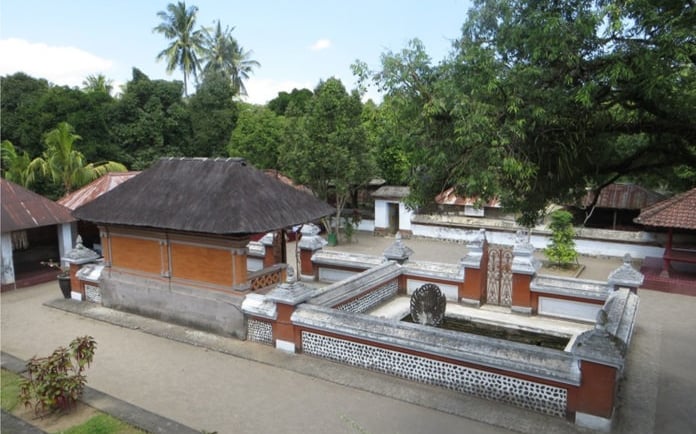Our guides speak English and German, Spanish, Dutch, France, Italian, Russian, Japanese, Arabic on request!
Exploring Lingsar Temple: A Harmony of Faith in Lombok
Lingsar Temple, located in Lombok, Indonesia, is a unique symbol of religious harmony, where Hinduism, Buddhism, and Islam coexist peacefully. This sacred site is celebrated for its annual Perang Topat festival, which brings together followers of these three faiths in a spirit of unity and mutual respect. The temple's architecture and rituals reflect a blend of cultural influences, making it a remarkable testament to the power of tolerance and shared spirituality.
Iwan Kur Kurniawan
1/23/20257 min read


Lingsar Temple in Lombok
Lingsar Temple, located in Lombok, Indonesia, stands as a remarkable testament to the harmonious coexistence of various religious beliefs. Established in the late 18th century, this temple is not merely a place of worship but a symbol of unity among diverse faiths. It is particularly significant as it serves practitioners of Hinduism, Islam, and Buddhism, reflecting Lombok's rich cultural diversity. This ability to accommodate multiple religions makes Lingsar Temple a unique spiritual site in the region.
Historically, Lingsar Temple was built during the reign of the Mataram Sultanate, serving primarily as a Hindu temple. Over the years, however, it evolved to embrace and integrate the spiritual practices of the indigenous Sasak people, who predominantly adhere to Islam. As a result, the temple complex features a variety of structures that represent the different faiths observed at the site. Such integration of different religious practices within a single location is quite rare, making Lingsar Temple a noteworthy example of religious syncretism.
The temple is most famous for its annual festival called "Pujawali," during which rituals and ceremonies are performed that honor the spirits of the ancestors. This event draws thousands of visitors and worshippers each year, as it symbolizes the collective faith and traditions of the local communities. Moreover, visitors can also explore the architectural beauty of the temple, characterized by intricate carvings and serene landscapes that enhance the tranquil ambiance of the site.
In essence, Lingsar Temple serves not only as a place for religious observance but also as an important cultural landmark, embodying the spirit of tolerance and mutual respect among different faiths. The ongoing legacy of Lingsar Temple highlights the importance of religious harmony in a world often divided by belief systems.
Architectural Features of Lingsar Temple
Lingsar Temple, located in Lombok, Indonesia, is an exemplary embodiment of the harmonious coexistence of different faiths. The architecture of this temple complex reflects a unique blend of Hindu and Islamic influences, which is a notable characteristic of its historical significance. The structure features traditional Balinese Hindu design, incorporated within an Islamic context, showcasing Lombok's rich cultural heritage.
The temple complex is laid out meticulously, with a design that promotes a sense of tranquility and reverence. Upon entering the site, visitors are greeted by a series of courtyards adorned with intricately carved statues and reliefs that depict various deities from both Hinduism and Islam. This artistic representation highlights the syncretic nature of the beliefs practiced here. The main temple, or Pura, stands majestically, with its vibrant colors and ornate details, encapsulating the artistic skill of its creators. The presence of the pool, or 'Telaga', where traditional rituals take place, reinforces the spiritual ambiance of the site.
Surrounding Lingsar Temple is breathtaking natural scenery, which enhances its ethereal appeal. Lush green landscapes and intricate water features contribute to the serene environment, allowing visitors to reflect and appreciate the tranquil atmosphere. The towering mountains in the backdrop provide a majestic frame, enriching the experience of worshipers and tourists alike. This natural setting complements the architectural marvel, making it a sanctuary for spiritual reflection.
In conclusion, the architectural features of Lingsar Temple not only encompass a fusion of Hindu and Islamic artistry but also create an inviting space for spiritual practice and contemplation. The thoughtful layout and the harmonious integration of natural surroundings play a pivotal role in establishing the temple's significance as a center of faith in Lombok.
Cultural Significance and Rituals
Lingsar Temple holds profound cultural significance in the heart of Lombok, Indonesia, serving as a prominent symbol of the island’s diverse religious heritage. Established in the early 18th century, it is a sacred site where both Hindu and Muslim communities coexist harmoniously, reflecting the essence of Indonesia’s rich tapestry of beliefs. This temple is not merely a place of worship; it represents a unique melding of traditions, fostering an environment that encourages interfaith dialogue and unity among various religious practices.
The rituals performed at Lingsar Temple are noteworthy for their inclusiveness and cultural depth. One of the most significant events is the annual Perang Topat (Rice War), a ceremonial clash between the Hindus and Muslims celebrating mutual respect and cooperation. Participants throw rice cakes at each other as a symbolic gesture of peace and friendship, reinforcing the shared values that bind these communities. This event attracts thousands of visitors, showcasing a vibrant display of colorful attire, traditional music, and dance, highlighting Lombok’s cultural diversity.
In addition to Perang Topat, other ceremonies such as the Gendang Belek and various rituals associated with the Lunar New Year add to the temple's ongoing cultural narrative. These events provide an opportunity for inter-religious collaboration and help to bridge gaps between followers of different faiths. By participating in these rituals, individuals not only reaffirm their devotion but also engage in a larger conversation about tolerance and understanding in a pluralistic society.
The significance of Lingsar Temple extends beyond its physical attributes; it embodies the spirit of coexistence in Lombok, facilitating dialogues that promote peace and enriching the cultural heritage of the region. Such rituals and ceremonies play a pivotal role in maintaining harmony among the island's diverse communities.
The Sacred Water Festival
The Sacred Water Festival, known locally as Pawitra, is a significant annual event held at the Lingsar Temple in Lombok, Indonesia. This festival, rooted in the rich heritage of the region, serves as a vibrant manifestation of the harmonious coexistence of various faiths, including Hinduism and Islam. Originating from ancient traditions, the festival reflects the community's deep respect for water, symbolizing purification, life, and unity.
As attendees immerse themselves in the festivities, the atmosphere is charged with spirituality and camaraderie. The blending of distinct rituals from various religious backgrounds illustrates the essence of the Lingsar Temple as a sanctuary where differences are celebrated. This festival not only attracts locals but also draws visitors from around the globe, fostering a sense of unity and respect for diverse beliefs.
The Pawitra festival serves as a vital cultural touchstone, ensuring the transmission of traditional values and religious practices to younger generations. It has become an integral aspect of the local community's identity, showcasing Lombok's ability to embrace diversity while promoting peace and understanding. In this way, the Sacred Water Festival at Lingsar Temple stands as a testament to the enduring spirit of collaboration and faith shared by the people of Lombok.
Visiting Lingsar Temple: What to Expect
For those planning a visit to Lingsar Temple, understanding the necessary preparations ensures a rewarding experience marked by respect and cultural appreciation. The temple, known for being a unique blend of Hindu and Islamic traditions, stands as a testament to the harmonious coexistence of faiths in Lombok. To get the most out of your visit, consider the optimal times to go and adhere to local customs.
The best times to visit Lingsar Temple are during the early morning or late afternoon. These periods provide a more temperate climate, making your exploration comfortable while allowing you to witness the temple in its serene beauty. Additionally, visiting during religious ceremonies, such as the Pujawali festival, enhances the experience, as the temple comes alive with vibrant rituals and communal worship.
Regarding dress code, it is crucial to dress modestly. Visitors should wear clothing that covers the shoulders and knees. Often, sarongs are provided at the entrance, and wearing one is considered a sign of respect. Respectful behavior is paramount; quiet observation during prayer sessions is encouraged, and refraining from taking photographs of worshippers actively engaged in rituals is advisable.
For those unfamiliar with local customs, remember that Lingsar Temple is a sacred site for many locals, and courteous interactions foster goodwill. Engaging in polite conversations with worshippers can enrich your understanding of the temple's significance. When navigating the area, it’s beneficial to have a local guide who can provide insights and facilitate respectful exchanges.
After visiting Lingsar Temple, consider exploring nearby attractions such as the Narmada Park and local markets, where you can immerse yourself further in Lombok's culture. Travel logistics are easy, as the temple is accessible by public transport or taxi services from the city center. Be sure to plan your journey ahead of time to maximize your experience at this remarkable spiritual landmark.
Interfaith Harmony and Community Impact
Lingsar Temple, located in Lombok, Indonesia, stands as a prominent example of interfaith harmony, exemplifying the peaceful coexistence of diverse religious beliefs. This temple, which is primarily a Hindu sacred site, harmoniously integrates elements of Islamic traditions, showcasing a unique blend of faiths that is often seen in Indonesian society. The presence of both Hindu and Islamic practices within Lingsar Temple fosters mutual respect and understanding, reinforcing the idea that different religious identities can coexist while contributing to the broader cultural tapestry of the community.
The community's engagement with Lingsar Temple extends beyond spiritual practices; it plays a significant role in initiating various community-led programs that promote inclusivity and cultural exchange. Events such as the annual Perayaan Pujawali, which celebrates both Hindu and Islamic traditions, draw participants from diverse backgrounds, fostering a sense of belonging and shared cultural identity. Such gatherings not only highlight the temple's importance as a religious site but also as a venue for building bridges among the local population. As a result, Lingsar Temple serves as a beacon of social cohesion, reflecting the values of tolerance and acceptance that are essential in today’s multicultural landscape.
Moreover, local initiatives organized around Lingsar Temple demonstrate the community's commitment to social welfare and cultural preservation. Programs aimed at educating the youth about both Hindu and Islamic customs help instill a sense of pride in their heritage while promoting interfaith dialogue. These initiatives not only strengthen relationships among different religious groups but also engage them in cooperative efforts to address community challenges, such as poverty and environmental sustainability.
Ultimately, the interfaith harmony exemplified by Lingsar Temple significantly impacts the Lombok community, reinforcing the notion that faith is a unifying force capable of transcending differences. It encourages a culture of peace and inspires collective action, demonstrating that when diverse communities come together, they can create a vibrant society that celebrates both individuality and unity.
Conclusion: A Symbol of Unity in Diversity
Throughout this exploration of Lingsar Temple, we have uncovered its significance as a remarkable symbol of unity amidst the rich tapestry of cultural and religious diversity found in Lombok. This temple, established in the 18th century, stands at the confluence of Hindu and Muslim beliefs, highlighting the harmonious coexistence that characterizes the local community. Visitors are often captivated by the diverse rituals and traditions practiced at the temple, which serve as a testament to the shared values and mutual respect upheld by different faiths.
Lingsar Temple's architecture is another element that embodies this spirit of cohabitation, with structures and designs reflecting both Hindu and Wetu Telu traditions. The temple's serene surroundings further contribute to its tranquil atmosphere, offering a place not only for worship but also for reflection and contemplation. This aspect is particularly appealing to travelers seeking an authentic cultural experience, allowing them to witness firsthand the local customs, rituals, and festivities that occur throughout the year.
Moreover, the annual ceremonies held at Lingsar Temple, such as the Perang Topat, symbolize the deep-rooted connection between the different faiths in the region, fostering an environment of understanding and camaraderie among diverse groups. Such events are a crucial reminder of the need for dialogue and collaboration in a world increasingly marked by division.
In conclusion, Lingsar Temple serves as a powerful testament to the potential for harmony in diversity. Its unique blend of spiritual practices and vibrant festivals encourages visitors to embrace inclusivity and celebrates the rich cultural heritage of Lombok. Therefore, we wholeheartedly recommend that travelers include Lingsar Temple in their itineraries, as it represents not only a religious site but also a celebration of coexistence, inviting all to partake in its exquisite legacy of unity.






